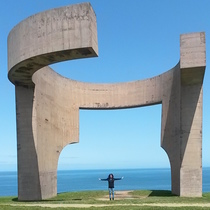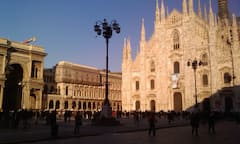Some months after opening, the Universal Exposition running in Milan until the 31st of October looked well on the way to surpassing previsions of 20 million visitors. Its vast site welcomes more than 140 participating countries that show the best of their ideas about the main theme of the event: being able to guarantee healthy and sufficient food for everyone, always respecting Nature and its equilibrium. Swarming with international families, elementary-school groups, bands of teenagers and university students, Expo 2015 also gives all the visitors the opportunity to taste the world’s best dishes, finding out about the gastronomic traditions of each country.
Visit the full Exposition in a day is impossible, so here I just want to give you some suggestions about what I think you shouldn’t miss! You have till the end of this month to enjoy it!
Where to start not to get lost

First of all, I want to reassure you: you’ll get a map ten seconds after your arrive at Expo village. This is pretty huge, but you will always find signs and nice people who will give you maps and information.
Entering from the main gates, you’ll encounter at first the Pavilion Zero that sets to the tone for the exhibition. It contains installations on the development of food, agriculture and general consumption along with mankind and it is a great way to present the Expo’s theme from the get go. After a quick visit to Pavilion Zero, you’ll arrive to the Decumano, the main boulevard of the Expo-village, that meets the Cardo (the names are taken from the structure of the ancient Roman cities) halfway. On the two sides of the main street are placed the countries pavilions, while the whole way is sprinkled with food stands.
Some countries chose to exhibit about the history and tradition of their food through a dedicated pavilion, and others to participate along with other countries in a cluster. These are not just geographical groupings of countries but more collaborations based on core ingredients (rice, legumes, spices, fruit, coffee, chocolate, etc). While I find the clusters interesting, the proper pavilions are really the stars of Expo. Since each country was allowed to design and build its own pavilion from the ground up, they all were given the opportunity to tell their story, and even better to have visitors taste their food.
The Colombia pavilion is worth waiting for

It’s not comparable with Japan or Brazil pavilions, but the queue that precedes the visit to Colombia pavilion is always quite long, so I suggest you to go early or at lunch time. I’ve waited about 90 minutes before entering, but the exhibition you can see inside is definitely worth the wait.
Imagine a country large of 144 million hectares, whereof 70% are dedicated to agricultural activities and livestock. Now beautify this with three mountain chains, access to two seas and an uncountable variety of animals and plants. Visiting the pavilion you will picture the paradise that Colombia is.
The pavilion architectural concept, designed by Manuel Villa Arquitectos from Bogota, takes inspiration from the five climatic zones of the country, which represent the different elevations, from the ground floor until the glaciers. Through the exposure to sounds, colors, aromas and textures, visitors discover the several weathers of Colombia, as well as its commercial potential, its people’s inventiveness and, above all, its ability in being naturally sustainable.
Kuwait Pavilion: watch the shooting stars in the desert

For a small country like Kuwait, characterized by an arid soil and climate, water is the most precious resource.
The pavilion (concept by Italo Rota and assigned to Progetto Cmr) offers a fascinating view of the territory of Kuwait, and shows the culture and the natural resources of a country born from a desert but able to create its own wealth anyway. Visitors have the possibility to walk along a promenade in the desert, immersed in landscapes recreated by 360 degree projection. You will even see the stars in the desert, surrounded by nothing else than dark and sand, really exciting!
Once arrived in the heart of the pavilion, the typical human environment of the country is showed through a big glass model representing the urban settlements and the petrol refineries.
Walking on, you will reach the suk, name for the typical markets of Arabian countries, where you can try and play with all the goods exposed: incense burners, teapots, oriental teas and perfumes, musical instruments and traditional games, jewels and dresses; a real dive in Kuwait market streets!
You might be interested in these Airbnbs!
The Tree of Life, a magic show of colours and lights

The Tree of Life, 37 meters in height, rises to the sky and reflects in the water of the Lake Arena. It has been “planted” at the end of the Cardo, the axis that connects the north and south of the Expo Site in front of the Italian Pavilion. The Tree of Life fits perfectly within the great metaphor of the nursery on which the concept of the Italian Pavilion is based. The Tree of Life is a place to meet up and relax, as well as a place for entertainment: you should not miss the great show of special effects and lights that it offers every hour, but especially at night!
Marco Balich, the Tree of Life designer who also serves as the artistic director for the Italy Pavilion, took inspiration from Michelangelo’s work, who conceived and drew a similar structure in Sixteenth Century for Piazza del Campidoglio in Rome. In addition to the Renaissance, this great structure also reflects a complex symbolic of Mother Nature shared by many cultures. This way, the Tree of Life represents the life force that gave birth to the universe.
Where to eat, after all this time walking?

It is possible to eat good food for a relative cheap price, but you have to remember some tips. The majority of pavilions offer gastronomic food in full-fledged restaurants, where top chefs consult or rotate through, cooking for a few days at a time. But there are also a few pavilions who have taken a more casual approach, with food trucks and snack carts.
Personally, I’ve had lunch at the Belgium pavilion and I really recommend it! The country has stands outside the pavilion selling typical waffles and French fries, the latter served in true Belgian style in a paper cone with either mayonnaise or ketchup. The beer stand offers a wide range of Belgian brews.
If you would like to taste other kind of food, you could trust also in Netherlands, Morocco and Italy Pavilions, other ways to eat good saving your money!
What are you waiting for? You have till the end of October to enjoy Expo 2015!
Visit Expo will be every time a new and exciting experience, because you will have the possibility to see every time different things, so make a plan and come to travel all around the world without moving from Milan! The Expo Tickets must be purchased online and the entry date booked in advance. Adult tickets cost 39 euros, but you can look for reductions through Medialease web page, that will also offer you the possibility to jump the entrance queue.
History
Get Trip101 in your inbox
Unsubscribe in one click. See our Privacy Policy for more information on how we use your data




















Create an account to